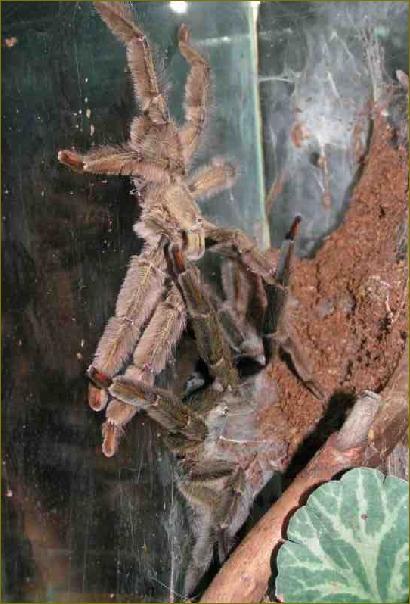
Breeding Psalmopoeus cambridgei
Michal Toran
On 11 June 1999, I got hold of a female P. cambridgei after her 2nd
moult when she was a spiderling. The spiderling was initially very gluttonous, like most kinds of a genus Psalmopoeus and the female
grew relatively quickly. The third moult followed on 18 November 1999. Next exuviations followed: 13.8.1999, 13.12.1999, 24.1.2000, 11.4.2000, 25.6.2000, 20.12.2000, 21.3.2001, 1.8.2001 and the last
moult into an adult, was on 11 February 2002. I kept the female until her 8 moult in a high plastic container, with average of 8 cm in size. Afterwards, I placed her into a glass terrarium with
dimensions 50 x 50 x 20 cm (height x width x length). I stuck over the back wall with pine wood cortex, with the help of silicone and, as a substrate, I used about 8 cm of lignocel. I also placed a
plant of (genus Scindapsus), which likes dampness, and a beautifully formed branch
of a corky oak tree. Temperature was kept about 24 degrees and the air humidity about 80%.
Some may say that I make too much fuss about an ordinary P.
cambridgei. However, this female was very vital and well grown so,
simply put, I would have been very sorry for oppressing her in some plain terrarium.
After 12 moults (on
11 Ferbuary 2002), her legspan measured 17 cm. I was persuaded that this moult was adult and therefore, I decided to get a male, because I didn't own any adult males at that time. I recieved a male
on 22 March 2002. In the evening on 24 March 2002, I placed the female and the male into a mating terrarium. The next day at about 22:00, I could see movement of the female and also of the male so I
decided to open the partition, which was between them.
Nothing happened for the first 15 minutes but soon,
both participants started to get closer to each other. Suddenly, without any signs of wanting to mate, the female attacked the male so I decided to separate them with the partition again. I still
kept them in the mating terrarium, however. When the female attacked the male, one ordinary wooden spoon proved useful, holding the female with it so the male had the chance to escape. Just to make
sure, I gave one pinkie mouse to the female, which she ate with appetite.
I tried to mate them
again on 31 March 2002. I opened the partition at about 21:00 and waited for what was going to happen. The female and the male were not interested in mating and were apathetic to each other.
This state lasted for about hour and a half. Afterwards, I push in the partition in again and decided to let both of them into the mating terrarium for some time so they could get used to one
another.
I tried to mate them one more time on 9 April 2002. However, nothing
was still happening during 2 hours after pushing out partition again so I decided to place both of them into the female's terrarium. She immediatelly ran to her nest and the male stayed dumbfounded
outside for a while. After 5 minutes, he started to move towards the female's nest, he was vibrating and drumming with his front legs onto the substrate. After a while, the female emerged out of the
nest and waited in the entrance. After about 20 minutes the courtship that consisted of light touches of front legs of both partners, the male managed to lift up the female and then push in his right
embolus into the female's genital opening for 5 minutes. Afterwards, the male quickly retreated but the female didn't follow him and remained still for several minutes and later returned to her
retreat. One day after, on 10 April 2002, the female sealed herself in her nest and didn't emerge again, even during the night.
She created her nest in a corner of the terrarium and therefore, I
sealed up this side with a black lightproof card so I could observe what was happening in the retreat. The female heavily silked the wall of the terrarium, which handicaped my observation. Despite
this, on 27 May 2002, I could see that the female was holdig an eggsac that measured about 3 cm on average. I sprayed the cage surroundings slightly and carefully until on 11 July 2002, I uncovered
the card on the corner of the terrarium and saw that the wall was inhabited by small spiders. I caught the female and then I counted exactly 40 nymphs in the second larval stage. They measured
approximately 0,5 cm. I didn't find any dead nymphs or unfertilized eggs. The sac was also not there, there were even no marks for it. I placed the nymphs onto a slightly dampened cotton pulp inside
a plastic box. On 17 July 2002, the nymphs started to darken and on 21 July 2002, the first one moulted into a spiderling. By 23 July 2002, already 35 nymphs were spiderlings. 5 nymphs didn't moult
and they died.
I was surprised that there were only 40 spiderlings as with this
species, more are usually produced. Compared to this, the spiders that survived were large enough and they were extremely active from the first time and they started to feed voraciously. Their food
consisted of shredded meal worms and crickets.
Afterward, I let the female have a rest and gave her a smaller pinkie
mouse. On the present, she occupies her newly created retreat in her own terrarium and she in an excellent condition (2002).
Author:Michal Toran, www.arachnomania.com
